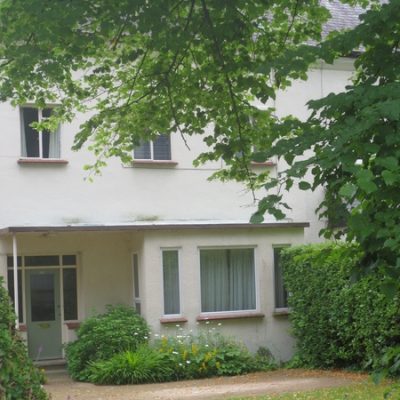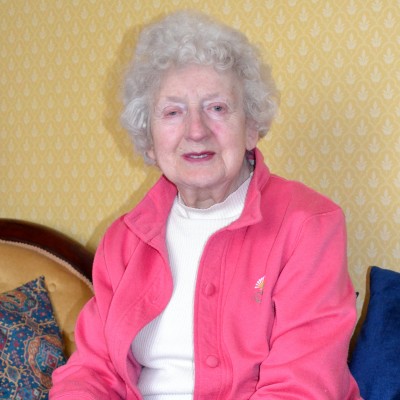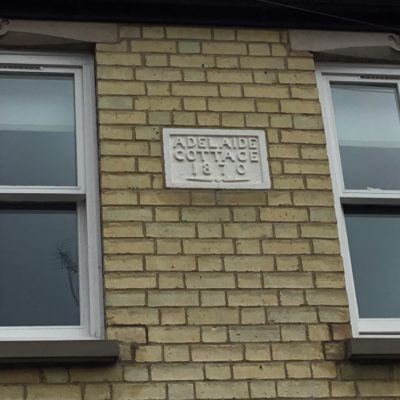Search by topic
- archaeology
- Building of Local Interest
- chapel
- charity
- church
- crime
- dressmaker
- fire
- Great Eastern Railway
- Listed building
- Mapping Relief
- medieval
- oral history
- poverty
- Public House
- Religious House
- Roman
- scholar
- school
- Then and Now
- tudor
- women
- work
- world war one
- world war two
Search by text
10 Ainsworth Street
10 Ainsworth Street
Number 10 is a single property standing between two terraces on the east side of Ainsworth Street.
1881 census
George S Farrow, head, 60, gardener, b. Runton nr Cromer, Norfolk
Mary A Farrow, wife, 59, b. Runton nr Cromer, Norfolk
George Simon Farrow and Mary Ann Abbs married in 1850.
1891 census
Mary Ann Farrow, head, widow, 66, living on her means, b. Runton, Norfolk
Rachael Millington, lodger, 77, receives Parish Aid, b. Cambridge
1901 census
Hannah Vail, head, 52, laundress, own account, b. Abington, Cambridgeshire
Catherine Vail, daughter, 28, laundress, b. Abington, Cambridgeshire
Florence Vail, daughter, 25, laundress, b. Cambridge
Alice M Vail, daughter, 23, laundress, b. Cambridge
Percy W Vail, son, 18, domestic house boy, b. Cambridge
William H Vail, son, 16, printer’s labourer, b. Cambridge
Sidney Vail, son, 14, printer’s labourer, b. Cambridge
Claude V Vail, son, 12, b. Cambridge
Mary Andrews, boarder, 87, b. Abington, Cambridgeshire
Lottie E Andrews, boarder, 7, b. London, Middlesex
Hannah Vail (née Andrews) was running her laundry business from the home. She and her family lived on Ainsworth Street for many years. In 1881 they were living at 20 Ainsworth Street, and in 1891 they were at 5 Ainsworth Street. By the time of the 1911 Census they were living at 25 Ainsworth Street.
Her daughter Catherine Vail married baker Edward Flood in 1902. In 1911 they were living at 16 Ainsworth Street with their son Claude Edward, born 1908. Electoral Registers show that from 1914 they were living back here at no. 10 (see 1921 Census below).
Alice Maud Vail died in 1905, her residence given as 61 St Johns Park, Islington. She was buried in Cambridge on 22 April 1905. Percy Walter Vail died on 30 June 1905, aged just 22.
William Henry Vail joined the 3rd Battalion of the Sussex Regiment as a Private in January 1903. He is described as 5’5” with a fair complexion, brown eyes, and light brown hair, with a tattoo on his left forearm. William served with them until 1909.
Back home in Cambridge, he had difficulty adapting to civilian life. In 1909 he appeared in court accused of ‘stealing a silver watch, of the value of 30s, the property of his mother’. Hannah Vail appeared in court and stated that ‘her son had given her a great deal of trouble’ and that ‘he came home drunk the previous day, and went to bed with his clothes on’. He was ‘constantly stealing her things and she was obliged to prosecute’. William was unable to find a surety of £5 to be on good behaviour, so the Magistrates sentenced him to one month’s imprisonment (Cambridge Independent Press, 2 April 1909).
In 1911 William was living at the Granville, 19 East Road.
In August 1914 he joined the 8th Battalion of the Norfolk Regiment (he also served with the 7th Service Battalion). He was wounded three times whilst serving in France, according to his service records. The last of these injuries was a gun shot wound to his head and chest, which he suffered on 30 November 1917 in Cambrai, France. This is the same day that he was declared missing. He had been captured by the Germans and became a prisoner of war. William was held at Limburg POW Camp, although it is possible that he was moved from there.
Prisoner of War Record for William Vail
His mother, Hannah, was told in late December that he was missing, and in January 1918 that he had been captured. William was repatriated on 2 January 1919.
On the 1939 register he is living at 3 Bulls Lane in Wisbech and working as an agricultural labourer. He died the same year (Cambridge Daily News, 9 Dec 1939):
The funeral of Mr William Henry Vail, who died at his sister’s home, 37 Sturton Street, on Sunday last, took place on Thursday at Mill Road Cemetery. The Rev. P. H. Potter, of St Barnabas, conducted the service. Deceased, who was 55, had been a land worker at Wisbech for 25 years.
He was buried on 7 December 1939.
For stories of Hannah’s other children – Rose, Florence, Sidney and Claude – see the profile for 25 Ainsworth Street.
1911 census
Ebenezer Peck, head, 28, house painter, b. Trumpington, Cambridgeshire
Matilda Peck, wife, 28, b. Harston, Cambridgeshire
Sybil Peck, daughter, 5
Frederick Peck, son, 3
Leslie Peck, son, 1
Ebenezer Henry John Peck married Matilda Annie Hayward in 1905.
Ebenezer served with the Cambridgeshire Regiment during the First World War.
An article in the Cambridge Independent Press for 5 February 1915, lists E.H.J. Peck as a new recruit for the newly formed ‘B’ Company of the Cambridgeshire National Reserve. It states that this B Company is formed of ‘old soldiers’, ‘perhaps, in many instances, past the heyday of their youth’, which suggests that Ebenezer had served before. ‘The Company will be called upon for service in East Anglia in the course of the next week or so. At present that are quartered at the Corn Exchange.’
The article lists him as living at Ross Street, so they had left Ainsworth Street by this point. Electoral registers show him at 127 Ross Street by 1920.
Matilda Peck died in 1954 and Ebenezer in 1959.
Sybil Peck married Walter Wood in 1931.
Frederick Peck became a painter and decorator like his father. He married Rita Craft in 1938 and they lived on Marshall Road.
Leslie Peck became a University Lab Assistant and married Lilian Heather in 1931. The 1939 register shows that he was trained for anti gas.
1921 census
Edward Flood, head, 45, baker, b. Cambridge
Catherine Flood, wife, 48, home duties, b. Abington, Cambridgeshire
Claude Flood, son, 12, b. Cambridge
In 1921 Edward Flood was working for F Cable, baker, at 9 Sturton Street.
Catherine Flood was the daughter of Hannah Vail, householder at no. 10 in the 1901 Census (see above). The Floods had lived at 16 Ainsworth Street in 1911, and Electoral Registers show that they had moved here to no. 10 by 1914.
Edward Flood was granted six months’ exemption from active service in 1916 (Cambridge Independent Press, 10 Nov 1916):
Edward Flood (40), married, one child, bread baker, 10 Ainsworth Street, was appealed for by Mr Howe on behalf of the employer Mr Loker, who, he said, was in France, on active service… Mr Miller said he did not object to temporary exemption. Six months exemption and leave to appeal again was granted.
His exemption was extended six months later (Cambridge Daily News, 15 May 1917):
Mrs. Agnes Loker, baker, of 74 Gwydir Street, applied for exemption for Edward Flood (41), married, 10 Ainsworth Street, bread baker, on the ground that he was the only man employed. Exemption was a granted until August 14th.
Edward and Catherine Flood remained at no. 10 until 1931. In the 1939 Register they were living at 37 Sturton Street. Edward was an ARP warden.
Edward died in 1945 and Catherine in 1967. They are buried in Mill Road Cemetery.
The Floods’ son Claude attended the Higher Grade School and possibly also the Perse Boys School. His name appears on a list of results of an examination for free places at the Perse School in 1919 (Cambridge Independent Press, 16 May 1919).
On 26 December 1936, Claude, now a baker like his father, married Hilda Lilian Clarke at St Barnabas. He gave his address as 89 Norfolk Street, which is still a bakery. However, on the 1939 Register he is no longer a baker. His job is unclear, but he is also listed as full-time ARP warden. He and Hilda lived at 35 Sturton Street, next door to his parents.
1939 Register
Ronald Hammond, b. 15 Jan 1912, painter and decorator
Ethel May Hammond. b. 20 Jan 1909, housewife
Two children (closed records)
Margaret O’Sheta, b. 1927, at school
Ronald Hammond and Ethel May Hunns were married in 1934. The Cambridge Directory for 1935 shows ‘R Hammond, Painter’ at no. 10.
During World War II Ronald served as a Private with the 2nd Battalion of the Cambridgeshire Regiment, 18th Division. [History of the 2nd Battalion Cambs Regiment during the Second World War]
The Battle of Singapore ended on 15 February 1942 when the Allies surrendered to the Japanese. Ronald was amongst those taken prisoner that day. (The Diary of Brian Oscar Denison – 2nd Bn Cambs. on COFEPOW.org.uk details events leading up to the 15th and for some days after capture.)
Ronald died on 7 February 1943. He is buried at the Chungkai War Cemetery in Thailand. COFEPOW.org.uk says ‘all the men buried in Chungkai perished while working on the infamous Thai/Burma Railway constructed during 1942/43’, and ‘At Chungkai War Cemetery in Thailand now rest those recovered from the southern part of the line, from Ban Pong to Nieke – about half its length.’
Ronald’s Memorial on FindAGrave.com.
Ronald’s entry on the Commonwealth War Graves Commission website.
In 1945 the electoral register shows Ethel still living at no. 10, along with a Mabel Rollings. In 1946 Ethel married Charles Frost Thomas. Charles was born in January 1918 and lived with his family at 6 Stone Terrace. He served with the 1st Battalion of the Cambridgeshire Regiment. Like Ronald, he was captured during the fall of Singapore on 15 February 1942.
Charles and Ethel Thomas lived together at no. 10 until 1963, when they moved to Weston Colville.
Sources: UK census records (1881 to 1911), 1939 Register, General Register Office birth, marriage and death indexes (1837 onwards), Cambridge Independent Press 07 July 1905 / 11 October 1907 / 02 April 1909 / 05 February 1915 / 05 May 1916 / 16 May 1919 Cambridge Daily News 15 May 1917 / 09 December 1939, Cambridgeshire Burials (FindMyPast.co.uk), Cambridgeshire Banns (FindMyPast.co.uk), British Army Service Records (FindMyPast.co.uk), British Armed Forces – First World War Soldiers’ Medical Records (FindMyPast.co.uk), Closed Pubs, Grande Guerre, England & Wales, Electoral Registers 1920-1932, British Army WWI Medal Rolls Index Cards, 1914-1920, England & Wales, Crime, Prisons & Punishment, 1770-1935, UK, Allied Prisoners of War, 1939-1945, Commonwealth War Graves Commission, Children and Families of Far East Prisoners Of War, Friends of Mill Road Cemetary
Contribute
Do you have any information about the people or places in this article? If so, then please let us know using the Contact page or by emailing capturingcambridge@
License
This work is licensed under CC BY-NC-SA 4.0










